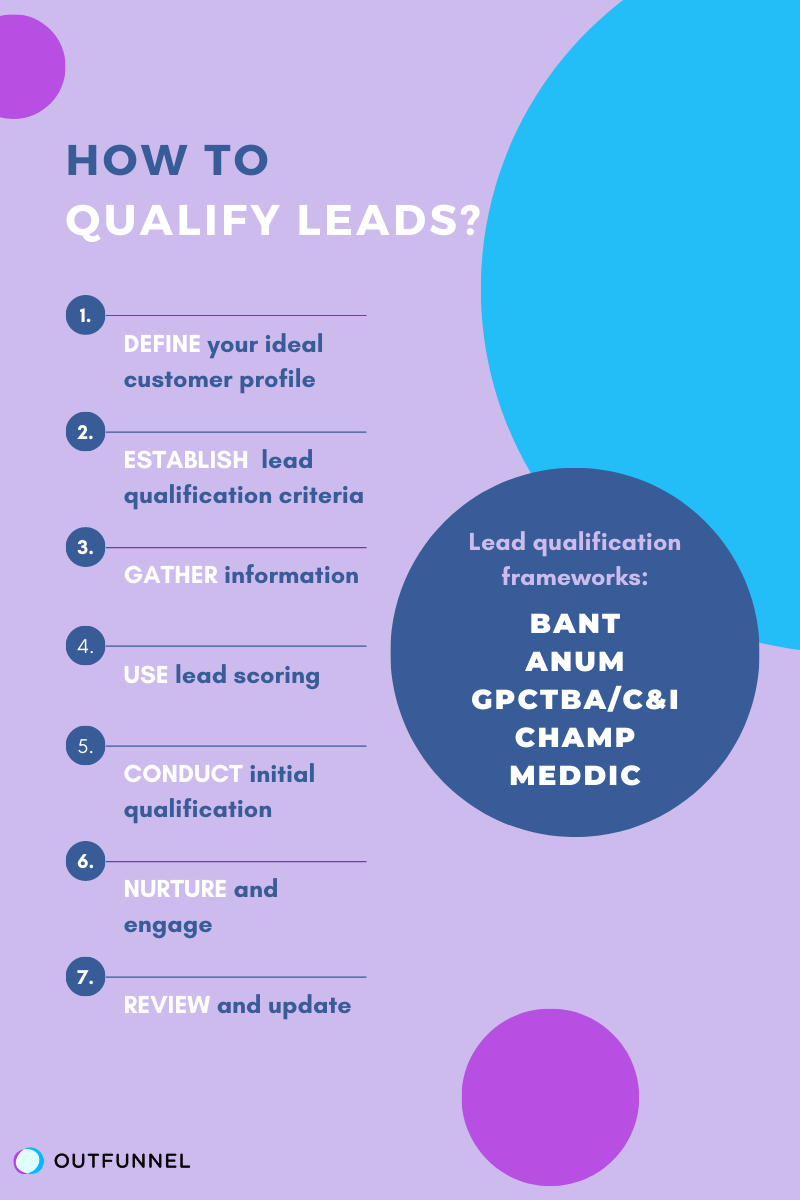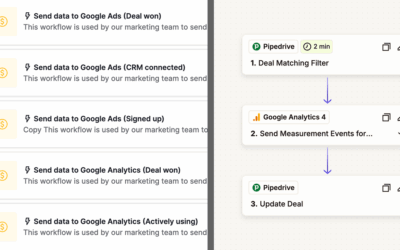You may have thousands of leads, but if contacting them takes most of your time and the conversion rate is less than 1%, you should think about optimizing the process.
So in this post, we’ll cover the main pain points about lead qualification, its frameworks, and the important steps for creating your own lead qualification process.
What is lead qualification?
Lead qualification is the process of deciding whether a lead is worth contacting or not. Qualifying leads correctly increases your conversion rate and decreases the time spent on contacting futile leads.
The lead qualification process starts from gathering data about a prospect until they become a customer.
Keep in mind that lead qualification is different for every team. For example, qualifying sales leads means those leads have to be ready to become customers. But marketing qualified leads can be simply interested in your product and content are warm (not hot ) leads because they are not ready to pay yet.
Read more about the differences between MQLs and SQLs here.
Benefits of lead qualification
Qualifying leads is important because it:
- helps you decide which leads are worth contacting
- helps you decide what kind of approach is needed to convert a lead into a customer
- saves you time and money
- improves your conversion rates and revenue
As mentioned above, there are different types of leads such as:
- Marketing qualified leads (MQL) – MQLs are leads that are interacting with your marketing campaigns but aren’t ready to buy yet.
- Sales qualified leads (SQL) – SQLs are leads that are ready to make a purchase. It means the sales team sees its worth to make contact with them.
- Product qualified leads (PQL) – PQLS are leads that have already experienced the value of your product.
- Conversion qualified leads (CQL) – CQLs are leads that have shown interest in any way on your website by clicking buttons or submitting forms by giving their email address.
- Unqualified leads – Leads that are unsure about your product or unable to make a purchase.

How to qualify leads?
Here is how you can qualify leads for your business:
- Define your ideal customer profile: Create a clear picture of your ideal customer. Consider factors such as demographics, industry, company size, job title, and specific needs that align with your product or service.
- Establish lead qualification criteria: Determine the criteria that a lead must meet to be considered qualified. This could include factors like budget, authority to make purchasing decisions, timeline, and level of interest or engagement.
- Gather information: Collect relevant information about your leads through various channels, such as website forms, social media, or lead generation campaigns. This data can include contact information, company details, and any other pertinent details that align with your qualification criteria.
- Use lead scoring: Develop a lead scoring system to rank and prioritize leads based on their fit with your ideal customer profile and their level of engagement. Assign numerical values to different criteria and actions, such as job title, company size, website visits, email opens, or downloads. This helps you objectively gauge the quality of leads and focus on those with higher scores.
- Conduct initial qualification: Reach out to leads to gather additional information and assess their interest and needs. This can be done through phone calls, emails, or online surveys. Ask relevant questions to understand their requirements, timeline, budget, and any challenges they may be facing. This step helps you determine if the lead meets your qualification criteria and if there is a potential fit.
- Nurture and engage: For leads that require further nurturing, provide them with valuable content, such as educational resources, case studies, or webinars, to build trust and maintain their interest. Engage with them through personalized emails, social media interactions, or targeted advertising campaigns.
- Review and update: Regularly review and update your lead qualification criteria and scoring system based on feedback from your sales rep and analysis of lead conversion data. This ensures that your qualification process remains effective and aligned with your business goals.
In addition, there are a few lead qualification mistakes that you should avoid at all costs. Read about the biggest lead qualification mistake that companies make and how to stay away from it.

What comes after lead qualification?
After lead qualification, sales qualified leads are forwarded into the sales pipeline whereas marketing qualified leads will be nurtured until they are ready to be moved into the sales lead qualification process.
Lead qualification example
Depending on the team, there are different examples of qualified leads.
For instance, a sales qualified lead may be someone who has expressed interest by requesting a demo or signing up for a free trial, and additionally meets the criteria of an ideal customer profile (ICP) or has participated in a qualification call with a sales representative.
Similarly, a marketing qualified lead is an individual who has engaged in actions such as downloading a whitepaper, subscribing to your newsletter, or visiting a pricing page.
In the context of Outfunnel, we define an MQL (Marketing Qualified Lead) as a prospect who has visited our pricing and feature pages. On the other hand, a PQL (Product Qualified Lead) is someone who has completed a signup, connected their CRM, and set up at least one of the three features: data sync, web visitor tracking, or lead scoring.
The fact that they’re interested in some of your content doesn’t mean that they’re ready to buy.
Elor Pruvli, B2B startup sales advisor at ScaleMode.io
How Lean Labs increased SQLs by 355%?
Lean Labs’ customer Atlantech Online offers services only in the Washington D.C metro area but they had lots of traffic and leads coming in from other countries as well.
They were disqualifying out-of-area contacts manually and were treating all the leads equally, which led to forwarding all of the leads to sales. As a result, qualifying leads was taking lots of time for sales, leading to a low conversion rate.
The solution was implementing lead scoring to determine SQLs and to see which ones need more lead nurturing. They added a “Get Started” widget with multiple onboarding steps. And those who completed all the steps were instantly qualified as hot SQLs.
This system helped them see which leads are MQLs that need more nurturing and which leads need to be contacted by sales right away.
The outcome: before the new system, Atlantech Online had 9 SQLs in 4 months, which is about 2 per month. But after the new system, they had 41 SQLs in 4 months, which is about 9 per month and a 355% monthly SQL increase.
Learn more about how to increase MQL to SQL conversion rate.
Start scoring your leads and increase led-to-win conversion rates by 25%
Deep integrations with CRMs like Pipedrive, HubSpot, Copper, Salesforce
Effective lead qualification frameworks
Lead qualification frameworks provide a structured approach to assessing and categorizing leads based on their fit and potential to become customers. The most commonly used sales qualification frameworks are BANT, ANUM, GPCTBA/C&I, CHAMP, and MEDDIC.
- BANT Framework: BANT stands for Budget, Authority, Need, and Timeline. This framework helps determine if a lead meets the basic criteria for qualification.
- Budget: Assess whether the lead has the financial resources to make a purchase.
- Authority: Determine if the lead has the decision-making power or influence within their organization.
- Need: Evaluate the lead’s specific needs, challenges, or pain points that your product or service can address.
- Timeline: Understand the lead’s timeline for making a purchase decision.
BANT works when treated as a framework, not a checklist. You need to ask additional questions in the order that is fit for you, not as the framework says. But it definitely lets you discover important information about a lead in a short time.
- 2. ANUM Framework: ANUM stands for Authority, Need, Urgency, and Money. This framework provides a broader perspective on lead qualification, focusing on the key aspects that drive conversions.
- Authority: Determine if the lead has the decision-making power or influence.
- Need: Assess the lead’s needs and challenges that align with your product or service.
- Urgency: Determine the level of urgency or time sensitivity regarding their need.
- Money: Evaluate the lead’s financial capability to invest in your offering.
ANUM is similar to BANT and CHAMP but focuses mostly on authority. But if you’re an enterprise company, you might want to choose MEDDIC instead (more on this later).
3. GPCTBA/C&I Framework: GPCTBA/C&I stands for Goals, Plans, Challenges, Timeline, Budget, Authority, Negative Consequences, and Positive Implications. This framework is often used in a consultative sales approach, focusing on understanding the lead’s situation comprehensively.
- Goals: Determine the lead’s goals and what they aim to achieve.
- Plans: Assess their existing plans or strategies to achieve those goals.
- Challenges: Identify the obstacles or challenges they face in reaching their goals.
- Timeline: Understand the lead’s timeline or sense of urgency for addressing their challenges.
- Budget: Evaluate their financial resources for investing in a solution.
- Authority: Determine their decision-making power or influence within the organization.
- Negative Consequences: Identify the negative outcomes or consequences if the lead doesn’t address their challenges.
- Positive Implications: Highlight the positive impact and benefits of resolving their challenges.
GPCTBA/C&I is mostly focused on understanding the company’s overall goals.
4. CHAMP Framework: CHAMP stands for Challenges, Authority, Money, and Prioritization. This framework prioritizes challenges, enabling sales professionals to adopt a modern approach to lead qualification.
- CHallenges: Identify the challenges, pain points, or problems the lead is currently facing. Understanding their specific needs and areas of difficulty allows you to tailor your approach and demonstrate how your product or service can address those challenges.
- Authority: Determine if the lead has the decision-making authority or influence within their organization. Assess their role and level of responsibility to understand if they can initiate or influence purchasing decisions. Engaging with the right decision-makers increases the chances of progressing the lead toward a sale.
- Money: Evaluate the lead’s budget and financial resources. Determine if they have the necessary funds to invest in your product or service. Understanding their budgetary constraints helps you qualify leads based on their capacity to make a purchase.
- Prioritization: Assess the lead’s sense of urgency and timeline for addressing their challenges. Understand if they have a clear timeline in mind and if their needs align with your own sales cycle. Prioritize leads that have a pressing need and are actively seeking a solution within a reasonable timeframe.
You’ll note that CHAMP is the newer version of BANT but prioritizes solving the problem over timing.
5. MEDDIC Framework: MEDDIC stands for Metrics, Economic Buyer, Decision Criteria, Decision Process, Identify Pain, and Champion. This framework focuses on the value that your product can bring to a lead. It’s perfect when you have a customer-centric approach.
- Metrics: Understand the specific metrics and key performance indicators (KPIs) that matter to the lead and their organization. Determine the goals and objectives they are trying to achieve and align your offering with their desired outcomes.
- Economic Buyer: Identify and engage with the person who has the authority to make purchasing decisions and control the budget. This individual, often known as the economic buyer, holds the power to approve and fund the purchase. It’s crucial to establish a relationship with this key decision-maker.
- Decision Criteria: Determine the factors and criteria that the lead considers essential in their decision-making process. Understand what specific requirements, features, or functionalities they are seeking in a solution. Align your product or service with their decision criteria to demonstrate its value.
- Decision Process: Gain a clear understanding of the lead’s decision-making process. Identify the steps involved, stakeholders or influencers, and any potential roadblocks or challenges along the way. This insight enables you to navigate the decision process more effectively.
- Identify Pain: Uncover and comprehend the pain points or challenges the lead is experiencing. Understand their motivations for seeking a solution and how your offering can address their specific needs. Position your product or service as the solution to their pain points.
- Champion: Identify a champion within the lead’s organization who supports your solution and can advocate for your offering internally. This person can provide valuable insights, navigate the organization, and influence the decision-making process in your favor.
MEDDIC framework can be implemented only if you have worked out your buyer personas, otherwise, it would be difficult.It’s perfect for qualifying enterprises.
As you can see, these frameworks provide a systematic approach to lead qualification and enable sales teams to prioritize their efforts effectively. You can customize and adapt these frameworks based on your specific business needs and industry. More importantly, remember that lead qualification is an iterative process, and you may need to refine your frameworks based on feedback and data analysis.
Improve your lead qualification process with Outfunnel
You can simplify your lead qualification process with Outfunnel Lead Scoring software. We pinpoint your best opportunities so you know which leads to contact first and which ones to keep nurturing. You can score leads based on all your sales and marketing data and integrate them with your CRM and marketing tools. Try 14 days for free.



